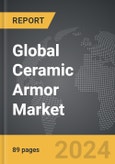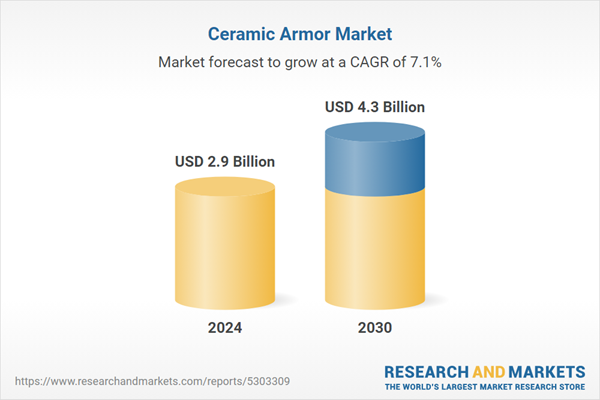The global market for Ceramic Armor was valued at US$2.9 Billion in 2024 and is projected to reach US$4.3 Billion by 2030, growing at a CAGR of 7.1% from 2024 to 2030. This comprehensive report provides an in-depth analysis of market trends, drivers, and forecasts, helping you make informed business decisions. The report includes the most recent global tariff developments and what they mean for your business.
Segments: Material Type (Silicon Carbide, Alumina, Boron Carbide, Other Material Types); Application (Body Armor, Aircraft Armor, Vehicle Armor, Marine Armor, Other Applications).
Geographic Regions/Countries: World; United States; Canada; Japan; China; Europe (France; Germany; Italy; United Kingdom; Spain; Russia; and Rest of Europe); Asia-Pacific (Australia; India; South Korea; and Rest of Asia-Pacific); Latin America (Argentina; Brazil; Mexico; and Rest of Latin America); Middle East (Iran; Israel; Saudi Arabia; United Arab Emirates; and Rest of Middle East); and Africa.
The analysts continuously track trade developments worldwide, drawing insights from leading global economists and over 200 industry and policy institutions, including think tanks, trade organizations, and national economic advisory bodies. This intelligence is integrated into forecasting models to provide timely, data-driven analysis of emerging risks and opportunities.
What Makes Ceramic Armor the Material of Choice for Modern Defense?
Ceramic armor has emerged as a critical technology in modern defense and security sectors due to its exceptional ballistic protection, lightweight nature, and enhanced survivability compared to traditional materials. As the global defense industry experiences an upsurge in modernization efforts, ceramic armor is increasingly preferred for its ability to withstand high-velocity impacts from projectiles and explosive fragments, offering soldiers and security personnel the much-needed balance between mobility and protection. The unique properties of ceramic materials, such as boron carbide, silicon carbide, and alumina, make them ideal for resisting penetration by hard-core ammunition, positioning them as a game-changing solution in military applications. In addition to soldier protection, ceramic armor is being rapidly adopted in vehicle armor, aircraft protection, and even naval applications, as it effectively absorbs and disperses the energy from attacks, minimizing the impact on the wearer or structure. Governments worldwide are prioritizing enhanced protective gear as part of their national defense strategies, creating a robust demand for ceramic armor systems. This growing adoption aligns with the broader trend of adopting high-performance materials in defense technologies, where the focus is as much on durability as it is on flexibility and comfort, ultimately contributing to the widespread integration of ceramic armor across diverse military sectors.How Are Technological Advances Transforming the Ceramic Armor Landscape?
Technological advancements in materials science have significantly transformed the ceramic armor landscape, leading to breakthroughs in ceramic composition and manufacturing processes. Innovations such as hot pressing, reaction bonding, and spark plasma sintering have enabled manufacturers to achieve higher densities and strength levels in ceramic armor plates, further enhancing their ability to withstand ballistic threats. A key development has been the integration of nanotechnology in ceramic production, which has contributed to creating ceramics with finer grain structures and improved performance under high-stress conditions. Additionally, advancements in composite materials - where ceramic armor is paired with fiber-reinforced plastics or metal matrices - have led to hybrid armor systems that offer superior protection without compromising weight. These technological strides are crucial in meeting the evolving demands of modern warfare, where enhanced mobility and stealth are just as important as resilience. Furthermore, digital design techniques such as CAD modeling and finite element analysis have enabled manufacturers to simulate and optimize armor performance before production, resulting in improved designs and shorter development cycles. These innovations not only enhance protection capabilities but also reduce manufacturing costs, making ceramic armor more accessible and economically viable for both developed and emerging markets. As technology advances, ceramic armor systems continue to evolve, responding to the dynamic needs of defense forces worldwide.Which Industries and Applications Are Fueling Ceramic Armor Demand Beyond Defense?
While the defense sector remains the largest consumer of ceramic armor, the adoption of these materials is rapidly expanding across other industries, notably in law enforcement, aerospace, and personal protection sectors. Civilian and federal law enforcement agencies increasingly use ceramic armor in protective vests and vehicle armoring, responding to the heightened risk environment faced by first responders. The aerospace sector also presents a promising frontier, with ceramic armor used in military aircraft and helicopters to provide lightweight, high-strength protection against small arms fire. Additionally, with a growing focus on public safety, ceramic armor is increasingly found in protective gear designed for critical infrastructure personnel, such as security guards at high-risk facilities. The trend extends to the commercial sector as well, particularly among companies that specialize in producing high-security vehicles or armored transport solutions for VIPs. Another promising area of growth is the private security market, where demand for premium protective solutions is fueled by increased political instability and the rise in private security firms across the globe. This diversification across industries highlights the expanding relevance of ceramic armor technology, demonstrating its potential to serve varied sectors with tailored solutions that prioritize lightweight, durable protection.What’s Driving Growth in the Ceramic Armor Market?
The growth in the ceramic armor market is driven by several factors, primarily propelled by advancements in technology, rising security concerns, and increasing government expenditure on defense. Rapid improvements in ceramic material science, such as the development of lighter, more resilient ceramics, have spurred adoption, as these materials meet the critical balance of weight reduction and high-performance protection. Another crucial factor is the growing demand for enhanced armor systems that can protect against evolving ballistic threats, necessitating ceramic solutions with superior impact resistance. The rising geopolitical tensions across regions have spurred governments to increase spending on soldier and vehicle protection equipment, creating substantial opportunities for ceramic armor producers. Furthermore, increased investment in research and development by private firms has led to innovative manufacturing techniques that lower production costs, making ceramic armor more accessible to civilian law enforcement agencies and commercial buyers. The global expansion of the private security sector, with increased demand for VIP and personal protection services, has also contributed significantly to market growth. Additionally, consumer behavior has shifted towards prioritizing lightweight, effective protective gear that offers maximum mobility, further accelerating demand. These factors, coupled with growing applications across aerospace, law enforcement, and personal security, underline the robust and sustained expansion expected in the ceramic armor market.Report Scope
The report analyzes the Ceramic Armor market, presented in terms of units. The analysis covers the key segments and geographic regions outlined below.Segments: Material Type (Silicon Carbide, Alumina, Boron Carbide, Other Material Types); Application (Body Armor, Aircraft Armor, Vehicle Armor, Marine Armor, Other Applications).
Geographic Regions/Countries: World; United States; Canada; Japan; China; Europe (France; Germany; Italy; United Kingdom; Spain; Russia; and Rest of Europe); Asia-Pacific (Australia; India; South Korea; and Rest of Asia-Pacific); Latin America (Argentina; Brazil; Mexico; and Rest of Latin America); Middle East (Iran; Israel; Saudi Arabia; United Arab Emirates; and Rest of Middle East); and Africa.
Key Insights:
- Market Growth: Understand the significant growth trajectory of the Silicon Carbide segment, which is expected to reach US$1.7 Billion by 2030 with a CAGR of a 7.2%. The Alumina segment is also set to grow at 7.9% CAGR over the analysis period.
- Regional Analysis: Gain insights into the U.S. market, valued at $743.9 Million in 2024, and China, forecasted to grow at an impressive 10.5% CAGR to reach $1.0 Billion by 2030. Discover growth trends in other key regions, including Japan, Canada, Germany, and the Asia-Pacific.
Why You Should Buy This Report:
- Detailed Market Analysis: Access a thorough analysis of the Global Ceramic Armor Market, covering all major geographic regions and market segments.
- Competitive Insights: Get an overview of the competitive landscape, including the market presence of major players across different geographies.
- Future Trends and Drivers: Understand the key trends and drivers shaping the future of the Global Ceramic Armor Market.
- Actionable Insights: Benefit from actionable insights that can help you identify new revenue opportunities and make strategic business decisions.
Key Questions Answered:
- How is the Global Ceramic Armor Market expected to evolve by 2030?
- What are the main drivers and restraints affecting the market?
- Which market segments will grow the most over the forecast period?
- How will market shares for different regions and segments change by 2030?
- Who are the leading players in the market, and what are their prospects?
Report Features:
- Comprehensive Market Data: Independent analysis of annual sales and market forecasts in US$ Million from 2024 to 2030.
- In-Depth Regional Analysis: Detailed insights into key markets, including the U.S., China, Japan, Canada, Europe, Asia-Pacific, Latin America, Middle East, and Africa.
- Company Profiles: Coverage of players such as 3M Company, Armorstruxx LLC, Armorworks Enterprises, LLC, BAE Systems, Ceramtec and more.
- Complimentary Updates: Receive free report updates for one year to keep you informed of the latest market developments.
Some of the 34 companies featured in this Ceramic Armor market report include:
- 3M Company
- Armorstruxx LLC
- Armorworks Enterprises, LLC
- BAE Systems
- Ceramtec
- Cerco Corporation
- Coorstek, Inc.
- FMS Enterprises Migun Ltd.
- Hard Shell
- II-VI Incorporated
- Koninklijke Ten Cate BV
- Morgan Advanced Materials PLC
- Point Blank Enterprises, Inc.
- SAAB AB
- Safariland, LLC
- Saint-Gobain
- Schunk Carbon Technology
- Seyntex NV
- Sinoarmor
- SM Group
Tariff Impact Analysis: Key Insights for 2025
Global tariff negotiations across 180+ countries are reshaping supply chains, costs, and competitiveness. This report reflects the latest developments as of April 2025 and incorporates forward-looking insights into the market outlook.The analysts continuously track trade developments worldwide, drawing insights from leading global economists and over 200 industry and policy institutions, including think tanks, trade organizations, and national economic advisory bodies. This intelligence is integrated into forecasting models to provide timely, data-driven analysis of emerging risks and opportunities.
What’s Included in This Edition:
- Tariff-adjusted market forecasts by region and segment
- Analysis of cost and supply chain implications by sourcing and trade exposure
- Strategic insights into geographic shifts
Buyers receive a free July 2025 update with:
- Finalized tariff impacts and new trade agreement effects
- Updated projections reflecting global sourcing and cost shifts
- Expanded country-specific coverage across the industry
Table of Contents
I. METHODOLOGYII. EXECUTIVE SUMMARY2. FOCUS ON SELECT PLAYERSIII. MARKET ANALYSISCANADAITALYSPAINRUSSIAREST OF EUROPESOUTH KOREAREST OF ASIA-PACIFICARGENTINABRAZILMEXICOREST OF LATIN AMERICAIRANISRAELSAUDI ARABIAUNITED ARAB EMIRATESREST OF MIDDLE EASTIV. COMPETITION
1. MARKET OVERVIEW
3. MARKET TRENDS & DRIVERS
4. GLOBAL MARKET PERSPECTIVE
UNITED STATES
JAPAN
CHINA
EUROPE
FRANCE
GERMANY
UNITED KINGDOM
ASIA-PACIFIC
AUSTRALIA
INDIA
LATIN AMERICA
MIDDLE EAST
AFRICA
Companies Mentioned (Partial List)
A selection of companies mentioned in this report includes, but is not limited to:
- 3M Company
- Armorstruxx LLC
- Armorworks Enterprises, LLC
- BAE Systems
- Ceramtec
- Cerco Corporation
- Coorstek, Inc.
- FMS Enterprises Migun Ltd.
- Hard Shell
- II-VI Incorporated
- Koninklijke Ten Cate BV
- Morgan Advanced Materials PLC
- Point Blank Enterprises, Inc.
- SAAB AB
- Safariland, LLC
- Saint-Gobain
- Schunk Carbon Technology
- Seyntex NV
- Sinoarmor
- SM Group
Table Information
| Report Attribute | Details |
|---|---|
| No. of Pages | 89 |
| Published | April 2025 |
| Forecast Period | 2024 - 2030 |
| Estimated Market Value ( USD | $ 2.9 Billion |
| Forecasted Market Value ( USD | $ 4.3 Billion |
| Compound Annual Growth Rate | 7.1% |
| Regions Covered | Global |









